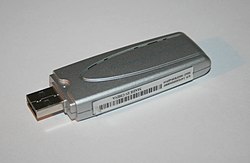A Wireless Network Interface Controller Can Work in
| | This article needs to be updated. (July 2013) |

A wireless network interface device with a USB interface and internal antenna

A Bluetooth interface carte du jour
A wireless network interface controller (WNIC) is a network interface controller which connects to a wireless network, such as Wi-Fi or Bluetooth, rather than a wired network, such every bit a Token Ring or Ethernet. A WNIC, just like other NICs, works on the layers 1 and 2 of the OSI model and uses an antenna to communicate via radio waves.
A wireless network interface controller may be implemented as an expansion card and connected using PCI motorbus or PCIe motorbus, or connected via USB, PC Bill of fare, ExpressCard, Mini PCIe or M.ii.
The low cost and ubiquity of the Wi-Fi standard means that many newer mobile computers have a wireless network interface built into the motherboard.
The term is unremarkably applied to IEEE 802.11 adapters; it may also apply to a NIC using protocols other than 802.11, such as 1 implementing Bluetooth connections.
Modes of operation [edit]
An 802.11 WNIC tin can operate in two modes known as infrastructure mode and ad hoc mode:
- Infrastructure way
- In an infrastructure mode network the WNIC needs a wireless access signal: all information is transferred using the access point as the key hub. All wireless nodes in an infrastructure mode network connect to an access point. All nodes connecting to the access point must accept the same service set identifier (SSID) as the access bespeak, and if a kind of wireless security is enabled on the access point (such as WEP or WPA), they must share the same keys or other authentication parameters.
- Advertisement hoc manner
- In an ad hoc fashion network the WNIC does not require an access point, just rather tin interface with all other wireless nodes straight. All the nodes in an advertising hoc network must accept the aforementioned channel and SSID.
Specifications [edit]
The IEEE 802.11 standard sets out low-level specifications for how all 802.11 wireless networks operate. Earlier 802.11 interface controllers are usually only compatible with earlier variants of the standard, while newer cards support both electric current and quondam standards.
Specifications normally used in marketing materials for WNICs include:
- Wireless data transfer rates (measured in Mbit/southward); these range from 2 Mbit/s to 54 Mbit/s.[1]
- Wireless transmit ability (measured in dBm)
- Wireless network standards (may include standards such as 802.11b, 802.11g, 802.11n, etc.) 802.11g offers data transfer speeds equivalent to 802.11a – up to 54 Mbit/s – and the wider 300-pes (91 m) range of 802.11b, and is astern uniform with 802.11b.
Most Bluetooth cards do not implement any class of the 802.11 standard.
Range [edit]
Wireless range may be substantially affected by objects in the way of the signal and past the quality of the antenna. Large electrical appliances, such as refrigerators, fuse boxes, metal plumbing, and air conditioning units can impede a wireless network signal. The theoretical maximum range of IEEE 802.11 is only reached under ideal circumstances and true effective range is typically about half of the theoretical range.[i] Specifically, the maximum throughput speed is only achieved at extremely shut range (less than 25 feet (seven.six m) or so); at the outer reaches of a device'southward effective range, speed may decrease to effectually 1 Mbit/south earlier it drops out altogether. The reason is that wireless devices dynamically negotiate the tiptop speed at which they can communicate without dropping likewise many data packets.
FullMAC and SoftMAC devices [edit]
In an 802.11 WNIC, the MAC Sublayer Management Entity (MLME) can be implemented either in the NIC's hardware or firmware, or in host-based software that is executed on the primary CPU. A WNIC that implements the MLME function in hardware or firmware is called a FullMAC WNIC or a HardMAC NIC[ii] and a NIC that implements it in host software is called a SoftMAC NIC.[3]
A FullMAC device hides the complexity of the 802.eleven protocol from the master CPU, instead providing an 802.3 (Ethernet) interface; a SoftMAC design implements only the timing-critical part of the protocol in hardware/firmware and the remainder on the host.[four]
FullMAC fries are typically used in mobile devices because:
- they are easier to integrate in consummate products
- power is saved by having a specialized CPU perform the 802.11 processing;
- the chip vendor has tighter control of the MLME.
Popular example of FullMAC chips is the one implemented on the Raspberry Pi 3.
Linux kernel's mac80211 framework provides capabilities for SoftMAC devices and additional capabilities (such as mesh networking, which is known equally the IEEE 802.11s standard) for devices with limited functionality.[5] [3]
FreeBSD likewise supports SoftMAC drivers.[half-dozen]
See also [edit]
- List of device bandwidths
- Wi-Fi operating system support
References [edit]
- ^ a b Meyers, Mike: Network+ Certification All-in-One Test Guide, McGraw-Hill, 2004, p. 230.
- ^ "Linux Wireless glossary". Definition of FullMAC. Retrieved 23 July 2020.
- ^ a b "Linux Wireless glossary". Definition of SoftMAC. Retrieved 23 July 2020.
- ^ Al-Sakib Khan Pathan (2010). Security of Cocky-Organizing Networks: MANET, WSN, WMN, VANET. Taylor & Francis. p. 28. ISBN978-1-4398-1919-7.
- ^ "mac80211 documentation". kernel.org.
- ^ "FreeBSD 11.0 - man page for upgt (freebsd section 4) - Unix & Linux Commands". Retrieved ane June 2016.
griffinwhisingerrim91.blogspot.com
Source: https://en.wikipedia.org/wiki/Wireless_network_interface_controller
Post a Comment for "A Wireless Network Interface Controller Can Work in"